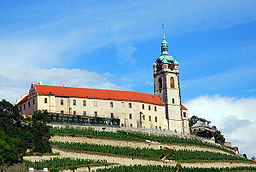Mělník
| Mělník | |||
| Town | |||
|
|||
| Country | Czech Republic | ||
|---|---|---|---|
| Region | Central Bohemian | ||
| District | Mělník | ||
| Commune | Mělník | ||
| Rivers | Elbe, Vltava | ||
| Elevation | 215 m (705 ft) | ||
| Coordinates | 50°21′7″N 14°28′30″E / 50.35194°N 14.47500°ECoordinates: 50°21′7″N 14°28′30″E / 50.35194°N 14.47500°E | ||
| Area | 24.97 km2 (9.64 sq mi) | ||
| Population | 19,201 | ||
| Density | 769/km2 (1,992/sq mi) | ||
| First mentioned | 1274 | ||
| Mayor | Ctirad Mikeš | ||
| Timezone | CET (UTC+1) | ||
| - summer (DST) | CEST (UTC+2) | ||
| Postal code | 276 01 | ||
| Statistics: statnisprava.cz | |||
Mělník (Czech pronunciation: [ˈmɲɛlɲiːk]; German: Melnik) is a town in the Central Bohemian Region of the Czech Republic. It lies at the confluence of the Labe and Vltava rivers, approximately 35 km north of Prague. The town is part of the Prague larger urban zone. The region belongs to the most important agricultural areas of the Czech Republic. The main agricultural produce are fruits, vegetables, potatoes, corn, sugar beet and wine.
In the 5th and 6th century many Slavonic tribes lived here, and the tribe of Pšovans created its main settlement in Mělník. Saint Ludmila (the grandmother of the Saint Wenceslas), who married the Bohemian prince Bořivoj, belonged to this tribe. Coins of the princess Emma are the first demonstration of the existence of Mělník. In November 1274 Mělník gained the statute of town from king Ottokar II of Bohemia and later became a dowry town belonging to queens of Bohemia.
The Mělník castle belongs to the most important sights of this town. The castle is built in the Renaissance style. Below the castle there are large wine cellars. Confiscated by the communists, it has been restored to its traditional owners, the princes of Lobkowicz.
The St. Peter and St. Paul's Church faces the Mělník castle. The church was rebuilt three times. The church is used primarily for religious functions, but everyone is able to look inside at the interior. The construction began at the turn of the 10th and 11th centuries. Starting in 2007 the public will be allowed access to the reconstructed church tower. There is a large and elaborate ossuary inside the church, which is a minor tourist attraction. Anthropologist Professor Jindrich Matiegka conducted research here between 1915-1919, during which he arranged the remains of 10-15,000 people.
...
Wikipedia





